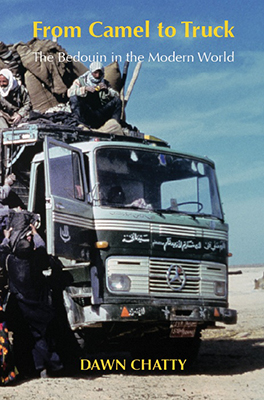From Camel to Truck
The Bedouin in the Modern World

Dawn Chatty
A new edition of Dawn Chatty’s seminal 1986 study of the Bedouin of Lebanon and Syria which investigates the community’s meshing of modernity and tradition as manifested in the transition from camel to truck as primary means of transport.
A classic study of cultural endurance and radical change in the Arabian desert
The Bedouin tribes of Northern Arabia have lived thousands of years as pastoralists, migrating across the semi-arid badia in search of graze and browse for their herds. Romantic images of Bedouin – black tents, robed Arabs and camels – still persist. However, mobile pastoral livelihoods have come under pressure to change in recent years. The modern nation-states of the Middle East view pastoralism as anachronistic and encourage Bedouin to become settled cultivators. An even more dramatic shift has taken place within the last few decades: the Bedouin have traded in their camels as beasts of burden in favour of the half-ton truck. The ship of the desert is now a Toyota, Datsun, Nissan or General Motors pick-up. Nevertheless, many Bedouin continue to herd livestock – sheep, goat and camel – at the same time as engaging in new economic activities. They have been open to remarkable change whilst firmly holding onto their culture, and their traditional moral and value systems. The truck has allowed many the possibility of interacting with the region’s modern economy while still pursuing their mobile pastoral livelihoods.
Extensive field research underlies anthropologist Dawn Chatty’s comprehensive study. She examines contemporary Bedouin society of Lebanon and Syria in the contexts of history, economy and political and moral culture. She details the consequences of motorized transport for this community – and she draws some surprising conclusions about its future viability.
LOOK INSIDE THIS BOOK at Amazon.co.uk
THE AUTHOR
Dawn Chatty is University Professor in Anthropology and Forced Migration and Director of the Refugee Studies Centre, Queen Elizabeth House, University of Oxford. Her research interests include coping strategies and resilience of refugee youth, nomadic pastoralism and conservation, gender and development, health, illness and culture. Her most recent books include: Dispossession and Displacement in the Modern Middle East (Cambridge University Press, 2010); Dispossession and Forced Migration in the Middle East and North Africa (ed. with Bill Finlayson, Oxford University Press, 2010); Deterritorialized Youth: Sahrawi and Afghan Refugees at the Margins of the Middle East, (ed. Berghahn Books, 2010); Nomadic Societies in the Middle East and North Africa: Facing the 21st Century (Brill, 2006); Children of Palestine: Experiencing Forced Migration in the Middle East (ed. with Gillian Lewando-Hundt, Berghahn Books, 2005); and Conservation and Mobile Peoples: Displacement, Forced Settlement and Sustainable Development (ed. with Marcus Colchester, Berghahn Press, 2002).
CONTENTS
List of Maps
List of Figures and Charts
List of Plates
Acknowledgements
Notes on Transliteration of Arabic Words
Foreword to the New Edition
Introduction
Chapter 1. The Bedouin and How They Came to Be Where They Are
Chapter 2. Pacification of the Bedouin in Northern Arabia
Chapter 3. Arab Society and the Bedouin
Chapter 4. The Camel: The Traditional Way of Life of a Bedouin Household
Chapter 5. The Truck: The Changing Pastoral Way of Life
Chapter 6. Conclusion: The Bedouin in the Modern World
Appendix A: Glossary
Appendix B: Table of Measures
Selected Bibliography
Index
January 2013, 200pp. Black and white illustrations, maps, figures
ISBN 978-1-874267-72-0 (PB) £28
